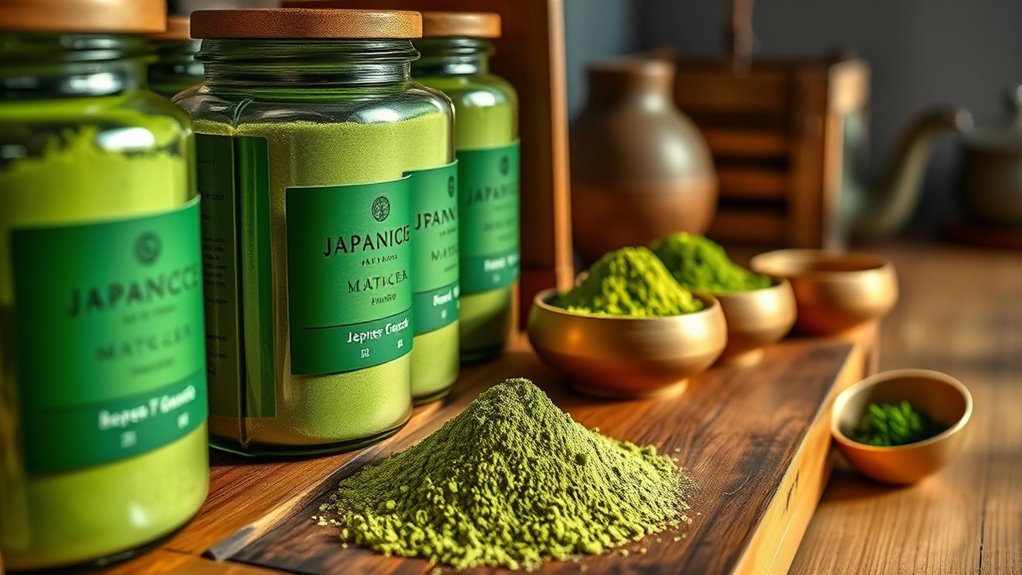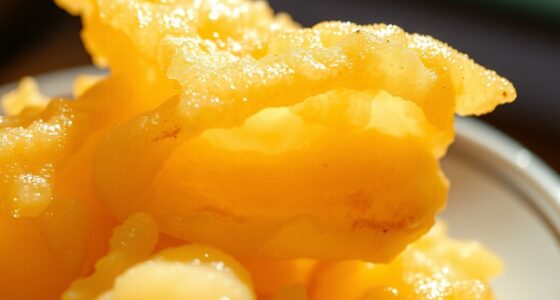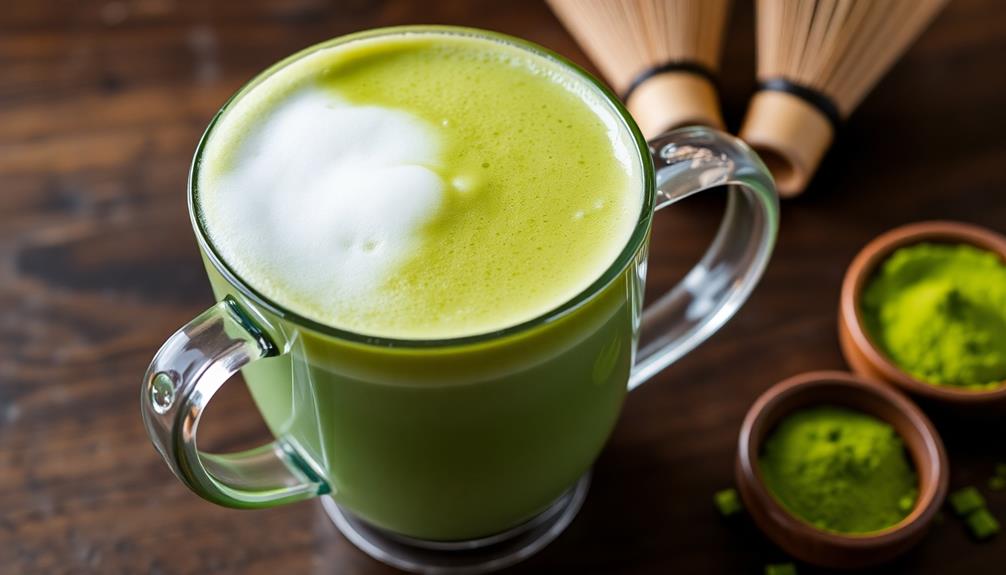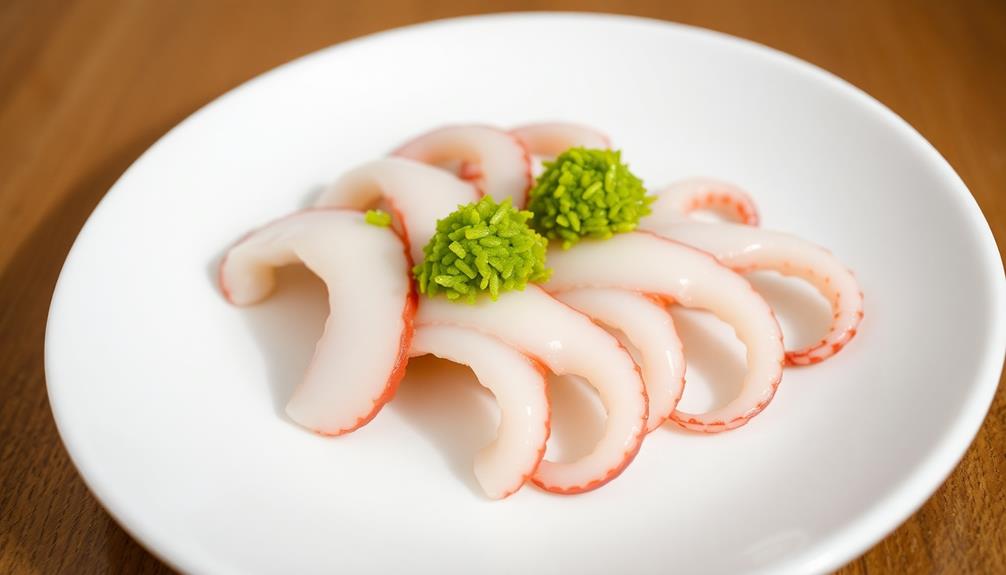Japanese matcha grades range from ceremonial to culinary, with ceremonial offering vibrant color, smooth texture, and subtle flavors ideal for traditional tea ceremonies. Culinary matcha is coarser, bolder, and suited for recipes like lattes or cooking. To keep your matcha fresh and vibrant, store it in an airtight, opaque container in a cool, dark place away from moisture and heat. Exploring these tips further can help you select and preserve the best matcha for your needs.
Key Takeaways
- Japanese matcha is graded mainly into ceremonial (highest quality, delicate flavor, vibrant green) and culinary (robust flavor, coarser texture) types.
- Ceremonial matcha features bright color, fine texture, and subtle, umami-rich flavor, ideal for traditional tea ceremonies.
- Culinary matcha has a duller green hue, coarser grind, and stronger flavor suitable for cooking, lattes, and smoothies.
- Store matcha in airtight, opaque containers away from light, heat, and moisture to preserve its vibrant color and flavor.
- Keep matcha in a cool, dark place like a pantry or cupboard; avoid refrigeration to prevent moisture and spoilage.

Japanese matcha grades vary widely, reflecting differences in quality, flavor, and intended use. When you’re exploring matcha, you’ll quickly notice that not all powders are created equal. The distinction between ceremonial and culinary grades is fundamental, as each serves a different purpose. Ceremonial matcha is crafted for traditional tea ceremonies, emphasizing smoothness, vibrant color, and subtle flavor nuances. It’s made from the youngest, most tender tea leaves, which are carefully shade-grown, harvested, and stone-ground into a fine, bright green powder. Culinary matcha, on the other hand, is designed for cooking and mixing into beverages like lattes or smoothies. It tends to be more robust, slightly less refined, and often has a deeper, earthier flavor. While both grades are made from high-quality leaves, the grading criteria differ primarily in leaf selection, processing, and intended use.
The grading criteria for matcha are quite specific. For ceremonial grade, you look for a bright, vibrant green color, indicating high chlorophyll content and freshness. The powder should be fine and smooth, with a delicate, sweet aroma. Its flavor profile is subtle and umami-rich, with a lingering sweetness that’s perfect for pure tea. Culinary matcha, however, may have a slightly duller green hue and a coarser texture. Its flavor is more intense, sometimes with bitter or roasted notes, which can stand up to milk, sugar, or other ingredients in recipes. These differences are rooted in how the tea leaves are grown and processed: ceremonial matcha uses the youngest leaves, shade-grown for a few weeks before harvest, then carefully stone-ground to preserve flavor and color. Understanding these grading criteria helps you choose the right matcha for your needs. When purchasing ceremonial grade, you look for descriptions emphasizing vibrant color, fine texture, and delicate aroma—perfect for sipping straight or using in traditional tea ceremonies. For culinary applications, focus on a richer, more robust flavor profile and a coarser grind, ideal for recipes, baking, or adding to drinks where the matcha’s strength enhances the overall flavor. Proper storage is just as vital to maintaining quality. Keep your matcha airtight, away from light, heat, and moisture. An opaque container in a cool, dark place, like a pantry or cupboard, will preserve its vibrant color and fresh flavor longer. Avoid refrigeration, as moisture can cause clumping or spoilage. Additionally, proper storage practices help retain the delicate flavor and color of high-quality matcha, ensuring it remains fresh over time. To further protect its quality, consider purchasing from reputable sources that specialize in premium matcha and provide detailed information about their processing methods. By understanding these distinctions and storage tips, you’ll guarantee your matcha remains fresh, flavorful, and suitable for your preferred use, whether sipping ceremoniously or cooking creatively.
Frequently Asked Questions
How Long Does Matcha Last After Opening?
After opening your matcha, it typically lasts about 1 to 2 months if stored properly. To maximize its shelf life, keep it in an airtight container away from light, heat, and humidity. Proper storage tips help preserve its vibrant flavor and aroma. Avoid exposing it to air frequently, and consider refrigerating if you won’t use it soon. This way, you can enjoy fresh, high-quality matcha for longer.
Can Matcha Be Stored in the Freezer?
Yes, you can store matcha in the freezer to help preserve its flavor. Make certain you use an airtight container to prevent moisture and odors from affecting it. Follow storage tips like dividing it into smaller portions for easy use, and always let it reach room temperature before opening to avoid condensation. Freezing helps keep your matcha fresh and flavorful longer, especially if you don’t plan to use it quickly.
Does Matcha Lose Potency Over Time?
Think of matcha like a treasure that slowly loses its sparkle over time. Yes, matcha loses potency if you don’t practice proper storage techniques, especially with age. To keep your matcha’s freshness, store it in an airtight container, away from light, heat, and humidity. While freezing can help preserve it, frequent thawing may diminish its flavor. Use it within a few months for the best taste and health benefits.
What’s the Best Way to Rehydrate Stale Matcha?
To revive stale matcha and improve its freshness, you should gently rehydrate it with a small amount of hot water, stirring smoothly to release its aroma and flavor. This method helps restore some of the Matcha freshness and makes it more enjoyable. Keep in mind, however, that stale matcha can’t fully regain its original vibrancy. For better results, store your matcha properly to prevent it from becoming stale in the first place.
Are There Health Benefits Specific to Certain Grades?
You might wonder if certain matcha grades offer unique health benefits. Different grades, like ceremonial or culinary, have grade differentiation that impacts not only flavor but also nutrient levels. Higher-grade matcha typically contains more antioxidants, which support your immune system and boost energy. Lower grades may have fewer beneficial compounds but can still provide a health impact. So, choosing the right grade depends on your health goals and preferred taste.
Conclusion
Now that you know the different Japanese matcha grades and how to store them, you’ll appreciate the subtle differences in flavor and quality with each cup. It’s funny how a simple change in storage can reveal hidden notes you never noticed before—almost like the matcha itself is revealing a secret. So, keep your matcha fresh, and you might just discover a new favorite just when you least expect it, turning everyday moments into something special.









